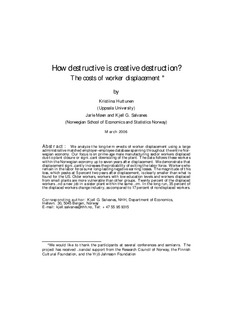| dc.contributor.author | Huttunen, Kristiina | |
| dc.contributor.author | Møen, Jarle | |
| dc.contributor.author | Salvanes, Kjell Gunnar | |
| dc.date.accessioned | 2006-07-11T10:56:49Z | |
| dc.date.available | 2006-07-11T10:56:49Z | |
| dc.date.issued | 2006-03 | |
| dc.identifier.issn | 0804-6824 | |
| dc.identifier.uri | http://hdl.handle.net/11250/162686 | |
| dc.description.abstract | We analyze the long-term effects of worker displacement using a large
administrative matched employer–employee database spanning throughout the entire Norwegian
economy. Our focus is on prime-age male manufacturing sector workers displaced
due to plant closure or significant downsizing of the plant. The data follows these workers
within the Norwegian economy up to seven years after displacement. We demonstrate that
displacement significantly increases the probability of exiting the labor force. Workers who
remain in the labor force suffer long-lasting negative earning losses. The magnitude of this
loss, which peaks at 5 percent two years after displacement, is clearly smaller than what is
found for the US. Older workers, workers with low education levels and workers displaced
from small plants are more vulnerable than other groups. Twenty percent of the displaced
workers find a new job in a sister plant within the same firm. In the long run, 35 percent of
the displaced workers change industry, as compared to 17 percent of nondisplaced workers. | en |
| dc.format.extent | 323692 bytes | |
| dc.format.mimetype | application/pdf | |
| dc.language.iso | eng | en |
| dc.publisher | Norwegian School of Economics and Business Administration. Department of Economics | en |
| dc.relation.ispartofseries | Discussion paper | en |
| dc.relation.ispartofseries | 2006:11 | en |
| dc.title | How destructive is creative destruction? : the costs of worker displacement | en |
| dc.type | Working paper | en |
